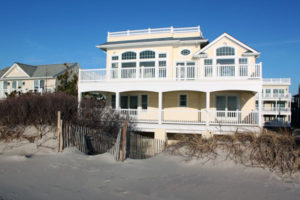 Many families dream of owning a custom home on Long Beach Island especially one that is on the water. With so many options for beachfront, lagoon front or bay front, choosing a lot to build on can be a difficult decision. It’s crucial that you understand what your ownership rights are and how these Riparian Rights can affect the use of your property and the home or structures you may wish to build on your property. Stonehenge Building & Development has built many custom homes on oceanfront, lagoon front and bay front properties, but we always recommend that our homeowners seek legal advice before purchasing their lot to be sure they fully understand land use for waterfront properties in New Jersey.
Many families dream of owning a custom home on Long Beach Island especially one that is on the water. With so many options for beachfront, lagoon front or bay front, choosing a lot to build on can be a difficult decision. It’s crucial that you understand what your ownership rights are and how these Riparian Rights can affect the use of your property and the home or structures you may wish to build on your property. Stonehenge Building & Development has built many custom homes on oceanfront, lagoon front and bay front properties, but we always recommend that our homeowners seek legal advice before purchasing their lot to be sure they fully understand land use for waterfront properties in New Jersey.
Here are three things to know before building a custom home on the water.
-
What are Tidelands?
Tidelands (also referred to as Riparian Lands) are all lands that are currently and formerly flowed by the mean high tide of a natural waterway. A good example of tidelands is Barnegat Bay. Sometimes tiny tidal streams that once flowed but are now filled in and developed, like New Creek in Newark, are also considered tidelands. So, even if you don’t SEE water on the property it could still be considered tidelands. All of these lands are owned by the State of New Jersey, held in trust for the people of the state. The Tidelands Resource Council, along with a branch of the Department of Environmental Protection known as the Bureau of Tidelands Management oversees all the tidelands, which are public lands.
-
What are Riparian Rights?
Riparian rights are the rights of owners adjacent to tidelands to be the first to request the use of those areas. Usually Riparian Rights extend from your waterfront property to a predetermined spot where bulkheads and docks are normally built. These lands are owned by all of the people of the State of New Jersey, so you must get permission from the State for the primary use of these lands in the form of a tide-lands license, lease or grant, and you must pay for this use. Some tidelands may be sold in the form of a Riparian Grant while others may only be rented through either a Tidelands License or Lease.
-
What is the Difference Between a Riparian Grant and a Tidelands License or Lease?
Because tidelands are public lands you must obtain written permission from the state and pay a fee before you are able to build any kind of docks, mooring piles, or bulkheads. Some tidelands may be sold in the form of a Riparian Grant and others may only be rented through either a Tidelands License or Lease. A Riparian Grant is usually provided by the State of NJ as a deed of sale for tidelands that have already been filled in and are no longer flowed by the tide. A Tidelands License is a rental agreement that is typically short-term and revocable, usually granted for structures including docks, bulkhead extensions, mooring piles and temporary structures, as well as dredging projects. These licenses are usually anywhere from one to ten years in length and can be renewed. According to the NJ DEP Division of Land Use Regulation website, current policy is to issue grants only for filled tidelands.
Riparian Rights can be a complicated matter, wrapped in legalize and complicated verbiage that should definitely be explained and understood with the help of your attorney. For more information on Riparian Rights and Land Use, please visit the New Jersey DEP website by clicking here. Once these complicated issues are resolved and the property is ready for your custom home to be built, Stonehenge Building & Development can make your waterfront home dreams come true! For more information on building a custom home on Long Beach Island, please contact us today.

